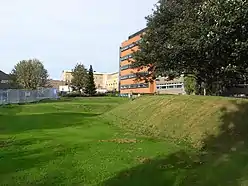Metchley Fort
Metchley Fort was a Roman fort in what is now Birmingham, England.[1]
| Metchley Fort | |
|---|---|
 The site of the fort, pictured here in 2009 | |
 | |
| Founded during the reign of | Julius Caesar |
| Founded | 43 AD |
| Abandoned | 120 AD |
| Place in the Roman world | |
| Province | Britannia |
| Directly connected to | Icknield Street |
| Location | |
| Coordinates | |
| Place name | Metchley |
| Town | Birmingham |
| County | West Midlands |
| Country | England |
| Reference | |
| UK-OSNG reference | SN643564 |
| Site notes | |
| Discovery year | 18th century |
| Condition | Earthworks, crop marks and ditches |
| Controlled by | Scheduled Monument (SAM: CD129) |
It lies on the course of a Roman road, Icknield Street, which is now the site of the present Queen Elizabeth Hospital and the University of Birmingham in Edgbaston. The fort was constructed soon after the Roman invasion of Britain in AD 43.[2] The fort was around 200 square metres (2,153 sq ft) in area and was defended by a turf and earth bank with a timber wall, towers and double ditches.[3] Within the fort were timber buildings including barrack blocks, a granary, a workshop and a store. In AD 70, the fort was abandoned, only to be reoccupied a few years later before being abandoned again in AD 120.
Remains have also been found of a civilian settlement, or vicus alongside the fort. It consisted of timber buildings and yards alongside a road leading from the fort's west gate, and was occupied for just a few years, when the fort was at its largest.[3]

The fort was extended on three sides by the addition of defended annexes, which were used for tethering horses, storage and small-scale industrial activity such as ironworking. Later the fort's buildings were replaced by other structures including compounds which suggest that it was now being used as a stores depot.[3]
The remains were first identified in the 18th century, although there were conflicting opinions on the origins of the earthworks. The date was confirmed in excavations that took place in the 1930s when the University of Birmingham Medical School was constructed. Further excavations took place in the 1940s and 1950s.[1] On 28 September 1953 the Lord Mayor of Birmingham, G. H. W. Griffith, opened the newly restored north-west corner of the fort. The reconstruction of the corner did not last long, however, as it was later destroyed by vandals.[4] More extensive excavations took place in the 1960s which uncovered various timber buildings within the fort. Mick Aston, who later became well-known on the TV programme Time Team, worked on the Metchley excavations in the late 1960s. Discoveries from excavations in the early 2000s included ovens and hearths, timber gateways, roads, the headquarters building, vessels from the Severn Valley and the Malvern Hills, and tableware from France.[1]
The remains of the fort are one of thirteen scheduled monuments in Birmingham.[5]
References
- "Birmingham's Roman Fort (Metchley)". Birmingham City Council. Archived from the original on 2008-05-10. Retrieved 2008-05-24.
- "Metchley Roman Fort". Historic England. Retrieved 7 April 2017.
- "Birmingham's Roman Fort (Metchley) Main Findings". Birmingham City Council. Archived from the original on 2008-05-11. Retrieved 2008-05-25.
- Victor Skipp, The History of Greater Birmingham - down to 1830, 1987, V. H. T. Skipp (ISBN 0-9506998-0-2)
- "Birmingham's Scheduled Ancient Monuments". Birmingham City Council. Archived from the original on 2008-05-10. Retrieved 2008-05-25.